Imagine hitting the open road with Washington’s breathtaking national parks as your backdrop. Over 14 days, you’ll explore lush rainforests, towering mountain ranges, and serene coastlines. This road trip offers a perfect blend of adventure and tranquility, allowing you to experience the best of the Pacific Northwest.
You’ll traverse iconic parks like Olympic National Park, Mount Rainier, and North Cascades, each offering unique landscapes and activities. Whether you’re hiking through old-growth forests, marveling at glacial peaks, or relaxing by alpine lakes, this itinerary ensures you won’t miss a thing. So, pack your bags and get ready for an unforgettable journey through Washington’s natural wonders.
Key Takeaways
- Optimal Itinerary Duration: A 14-day road trip allows you to thoroughly explore Washington’s national parks, including Olympic National Park, Mount Rainier, and North Cascades.
- Park Highlights: Each park offers unique landscapes and activities, from the rainforests and coastlines of Olympic to the alpine meadows of Mount Rainier and the rugged beauty of North Cascades.
- Seasonal Travel Tips: The best time to visit is from June to October, offering pleasant weather, clear skies, and accessible roads and trails.
- Essential Planning: Renting a reliable vehicle, booking accommodations in advance, and packing layered clothing are crucial for a successful trip.
- Sustainable Practices: Practice Leave No Trace principles, support local businesses, and consider carpooling to minimize environmental impact.
- Budget Considerations: Plan for national park entrance fees, varying accommodation costs, and potential savings through camping or off-season visits.
How Many Days to Spend for Washington Road Trip Itinerary
Planning a Washington road trip itinerary that includes visits to all three majestic national parks needs at least 14 days. This timeframe ensures you won’t miss out on the rich experiences each park offers, from the lush rainforests to the towering peaks. Here’s a practical breakdown to optimize your adventure:
Olympic National Park: 2-3 Days
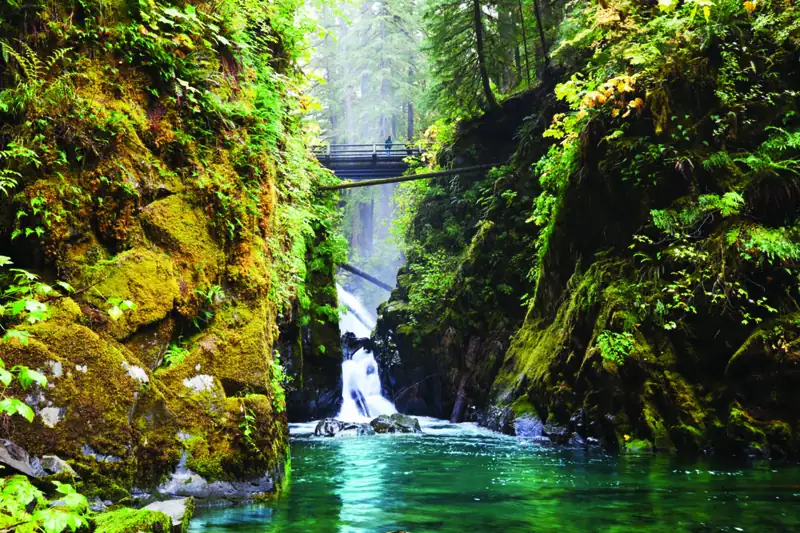
Jump into the diverse landscapes of Olympic National Park. Spend 2-3 days exploring the lush Hoh Rainforest, the rugged coastline of Rialto Beach, and the breathtaking views from Hurricane Ridge. Start your morning with a hike through the moss-draped forest, then unwind by the pristine waters of Lake Crescent. If you’re lucky, catch a sunset at Ruby Beach, with its dramatic sea stacks.
Mount Rainier National Park: 2-3 Days

Mount Rainier demands 2-3 days to fully appreciate its grandeur. Begin at Paradise, where wildflower meadows paint the world in summer. Hike the Skyline Loop Trail for awe-inspiring views of glaciers and the iconic peak. Sunrise, on the mountain’s eastern flank, offers less-crowded trails and equally stunning vistas. Don’t miss Grove of the Patriarchs for its ancient, towering trees.
North Cascades National Park: 2-3 Days
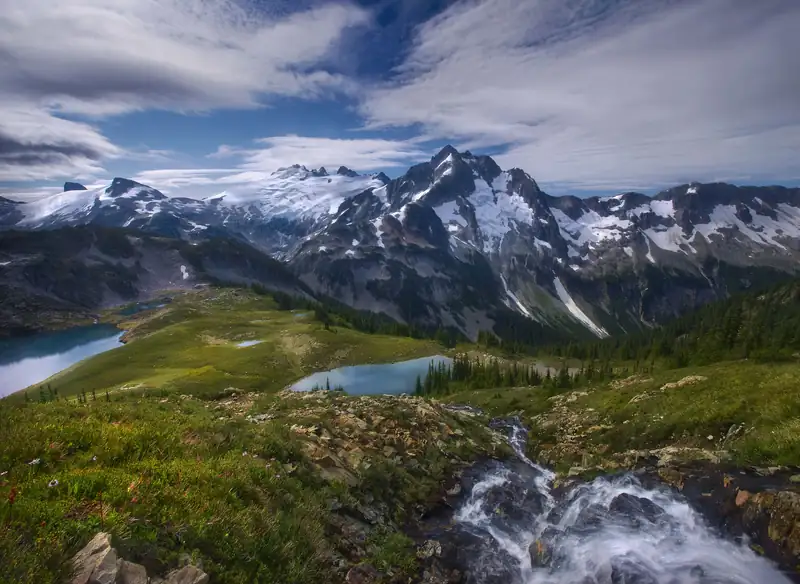
North Cascades is a hidden gem that shines over 2-3 days. Drive the North Cascades Highway, stopping at viewpoints like Diablo Lake for turquoise waters amidst jagged peaks. Hike the Cascade Pass Trail to feel enveloped by alpine meadows and panoramic mountain views. For a unique experience, visit the Stehekin Valley, accessible only by boat, foot, or plane.
Essential Tips for Crafting Your Itinerary
Transportation and Practical Tips: Rent a reliable vehicle, as the parks are remote. Fuel up frequently, especially in the North Cascades.
Accommodation: Book in advance, especially for peak summer months. Consider a mix of lodges, campgrounds, and Airbnb options.
Seasonal Variations: Summer offers the best weather, while shoulder seasons (spring and fall) provide fewer crowds and vibrant foliage. Check weather conditions before hitting the trails.
Sustainability Tips: Practice Leave No Trace principles. Support local businesses to boost the economy sustainably.
Budget Considerations: National park entrance fees range from $30 per vehicle. Accommodations vary from budget-friendly campsites to luxurious lodges.
Accommodation Comparison
| Park | Type | Price Range | Notes |
|---|---|---|---|
| Olympic National | Campgrounds, Lodges | $20-$150 | Book lodges early in peak season |
| Mount Rainier | Cabins, Campgrounds | $25-$200 | Paradise Inn is a historical gem |
| North Cascades | Rustic Cabins, Inns | $15-$175 | Limited options, plan ahead |
Dining Highlights
Indulge in local cuisine at roadside diners and park lodges. Olympic offers seafood delights; don’t miss the clam chowder. Mount Rainier’s National Park Inn serves hearty meals with a view. For a unique taste, try North Cascades’ Stehekin Pastry Company in the remote Stehekin Valley.
By spending at least 14 days on your Washington road trip, you’ll intimately connect with each park’s distinct beauty, creating unforgettable memories along the way.
Best Time to Take a Washington National Parks Road Trip
Overview
The optimal time for a Washington national parks road trip is during summer or fall, from June to October. This period offers pleasant weather and maximum accessibility, ensuring a seamless and enjoyable adventure through the parks.
Reasons for Summer/Fall Preference
- Weather: Clear skies and warm temperatures define summer and fall in Washington. These seasons typically provide dry conditions perfect for hiking, camping, and exploring various national parks. For example, the summer months have average daytime highs between 70°F and 80°F, making outdoor activities comfortable.
- Accessibility: Roads like Highway 20, critical for accessing North Cascades National Park, generally close from November through May due to snow. Opting for a summer or fall trip ensures all roads and trails are open. You’ll have unhindered access to iconic sites like Diablo Lake and Stehekin Valley.
Climate Data Table
Here’s a snapshot of the seasonal weather:
| Season | Average High (°F) | Average Low (°F) | Rainy Days |
|---|---|---|---|
| Summer | 70-80 | 50-60 | 5-8 |
| Fall | 60-70 | 40-50 | 6-10 |
Seasonal Variations
- Summer (June-August): Long daylight hours provide ample time for exploring. Iconic wildflower meadows at Mount Rainier’s Paradise area bloom most vibrantly in July.
- Fall (September-October): Fewer crowds and stunning autumn foliage await you. The changing colors in Olympic National Park’s Hoh Rainforest create a magical atmosphere, perfect for photography enthusiasts.
Sustainability Tips
Traveling during the less-crowded fall season helps reduce environmental impact and supports sustainable tourism practices. Consider carpooling or using shuttle services available in some parks to minimize your carbon footprint.
Budget Considerations
Visiting in early June or late September might help you avoid peak-season rates for accommodations and activities. Keep an eye out for off-season discounts and package deals.
Exploring Washington’s national parks in summer or fall ensures you get the most out of your road trip. Whether it’s hiking up Mount Rainier, taking scenic drives through North Cascades, or enjoying the coastal beauty of Olympic, the favorable weather and open roads will make your journey unforgettable.
Essential Tips for Your Washington Road Trip
Plan Your Route
Mapping out your journey ensures you maximize time in each park. Start in Olympic National Park, then head to the Mt. Baker region, followed by North Cascades and Mt. Rainier National Park. Use online tools like Google Maps to plan driving routes and estimate travel times.
Pack Smart
Pack essentials like layered clothing, waterproof gear, hiking boots, and a first aid kit. Don’t forget a reusable water bottle, sunscreen, and insect repellent. A detailed packing list helps you stay organized and prepared for varying weather conditions.
Best Time to Visit
June to October offers pleasant temperatures and clear skies. Wildflower blooms in July and autumn foliage in September and October are highlights. Check park websites for any seasonal road closures or trail conditions.
Top Attractions
- Olympic National Park: Hurricane Ridge, Hoh Rainforest, Rialto Beach
- Mt. Baker Region: Local trails, scenic views
- North Cascades National Park: North Cascades Highway, Stehekin Valley
- Mt. Rainier National Park: Wildflower meadows, Sunrise and Paradise areas
Hidden Gems
Explore lesser-known spots like Shi Shi Beach in Olympic National Park and the remote trails of the Mt. Baker-Snoqualmie National Forest. These areas provide solitude and unique encounters with nature.
Accommodations
A variety of accommodations cater to all budgets, from campgrounds to luxury lodges. Here’s a quick comparison:
| Type | Price Range | Locations |
|---|---|---|
| Campgrounds | $15-$30/night | All parks |
| Mid-range Hotels | $100-$150/night | Near park entrances, towns like Port Angeles |
| Luxury Lodges | $250+/night | Select locations like Lake Quinault and Paradise Inn |
Dining Highlights
Savor local cuisine at roadside diners and park lodges. Olympic National Park’s Lake Crescent Lodge serves locally sourced seafood, while North Cascades offers cozy cafes with stunning mountain views.
Transportation & Practical Tips
Rent a reliable car for flexibility. Some park areas require advanced permits, especially for popular hikes. Always check trail conditions and carry a map.
Sustainability Tips
Reduce your environmental impact by carpooling, using reusable containers, and sticking to marked trails. Off-peak visits also help lessen crowding and protect park ecosystems.
Budget Considerations
Save money by booking accommodations early, using a National Parks Pass for entry fees, and preparing some meals. Many parks offer free ranger-led programs, which add value to your trip.
Following these essentials ensures a smooth and enjoyable road trip through Washington’s breathtaking national parks.
Planning Your 14-Day Washington Road Trip Itinerary
Days 1-2: Seattle
Start your Washington road trip in the vibrant city of Seattle. Known for its eclectic mix of natural beauty and urban attractions, Seattle offers a perfect kickoff to your adventure. By beginning your journey here, you’ll have the chance to soak up the city’s unique charm before diving into the state’s stunning national parks.
Top Attractions
- Pike Place Market: Wander through this historic market where you can enjoy fresh seafood, local produce, and watch entertaining fish-throwing vendors.
- Space Needle: Take in panoramic views of the city and Puget Sound from this iconic landmark.
- Chihuly Garden and Glass Museum: Marvel at stunning glass sculptures created by artist Dale Chihuly.
- Olympic Sculpture Park: Explore outdoor art installations set against the backdrop of Elliott Bay.
- Discovery Park: Enjoy hiking trails with beach access and views of the Puget Sound.
- Golden Gardens Beach: Relax by the water, picnic, and observe marine life.
- Seattle Troll: Visit the quirky Fremont Troll under the Aurora Bridge.
- Gas Works Park: Revel in the unique blend of industrial ruins and green space.
- Seattle Great Wheel: Ride one of the largest Ferris wheels on the West Coast.
Hidden Gems
- Ballard Locks: Watch boats pass through and observe the salmon ladder where fish migrate.
- Kubota Garden: Find peace in this beautiful Japanese garden in Rainier Beach.
- Kerry Park: Capture stunning views of the Seattle skyline from Queen Anne Hill.
Accommodations
| Accommodation Type | Examples | Price Range | Features |
|---|---|---|---|
| Luxury Hotels | Four Seasons Hotel, The Fairmont | $300-$600 per night | High-end amenities, central locations, on-site dining |
| Mid-Range Hotels | The Maxwell Hotel, Hotel Monaco | $150-$300 per night | Comfortable rooms, good amenities, central locations |
| Budget Accommodations | Green Tortoise Hostel, Motel 6 | $50-$150 per night | Basic amenities, budget-friendly, convenient locations |
Dining Highlights
- Seafood: Enjoy fresh catches at The Walrus and the Carpenter or Ivar’s Acres of Clams.
- Coffee: Don’t miss Seattle’s revered coffee culture with a visit to the original Starbucks at Pike Place Market or local favorites like Stumptown Coffee.
- International Cuisine: Savor diverse options from Mexican at El Borracho to Vietnamese at Ba Bar.
- Farm-to-Table: Experience local flavors at restaurants like Canlis or Terra Plata.
- Getting Around: Use Seattle’s efficient public transport including buses, light rail, and streetcars. Consider renting a bike or scooter for short trips.
- Parking: Available but can be pricey. Look out for parking garages or opt for street parking where available.
- Weather: Summer (June-August) offers the best weather with mild temperatures. Fall (September-October) is also pleasant with fewer crowds.
- Packing: Bring layered clothing to adjust to Seattle’s variable weather. A waterproof jacket is a must.
- Sustainability Tips: Use public transport, bring reusable bags and water bottles, and support eco-friendly businesses.
By exploring Seattle’s top spots, hidden gems, and integrating practical tips into your planning, you set a strong foundation for the unforgettable national park experiences to follow on your Washington road trip adventure.
Days 3-5: Olympic National Park
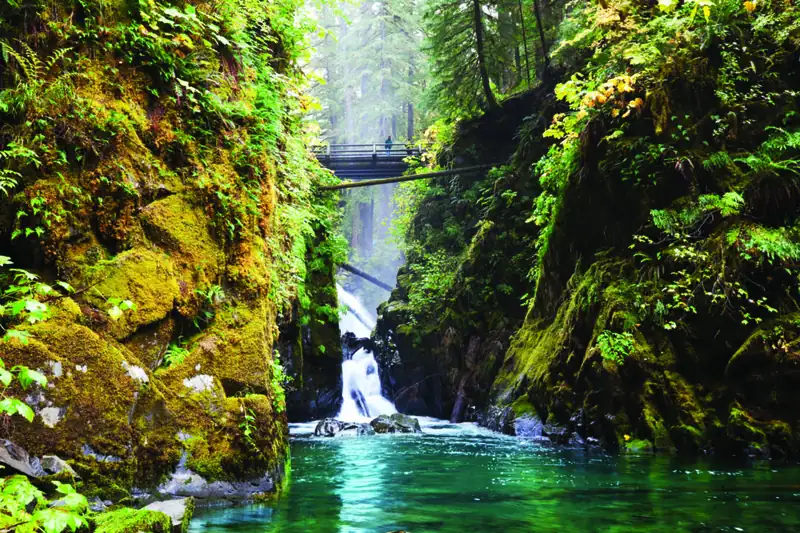
Olympic National Park offers a striking diversity of ecosystems, from lush rainforests to rugged mountains. This segment of your road trip plunges you into natural beauty few places can match.
Getting to Olympic National Park
Getting to Olympic National Park from Seattle takes about 2 hours and 45 minutes. Most travelers drive west, typically passing through the scenic towns of Port Angeles or Forks. These towns are excellent bases for day trips into the park, providing convenient access to various park areas.
What to Do in Olympic National Park
Temperate Rainforests
- Hoh Rainforest: Explore the famous Hall of Mosses trail, where tree limbs draped in moss create an otherworldly atmosphere.
- Quinault Rainforest: Another essential stop, offering short and long trails amidst towering old-growth trees and lush vegetation.
Mountain Areas
- Hurricane Ridge: Hike trails suitable for all skill levels while soaking in panoramic mountain views. Keep an eye out for wildlife like black-tailed deer.
- Mount Storm King: Begin on a challenging hike to the summit for breathtaking views of Lake Crescent and the surrounding peaks.
Where to Stay in Olympic National Park
Here’s a handy comparison of accommodation options in and around Olympic National Park:
| Accommodation | Location | Highlight | Price Range |
|---|---|---|---|
| Lake Crescent Lodge | Lake Crescent | Historic lodge by the lake | $$ |
| Kalaloch Lodge | Coastal | Oceanfront cabins | $$ |
| Sol Duc Hot Springs Resort | Sol Duc Valley | Natural hot springs | $$$ |
| Camping | Various | Close-to-nature experience | $ |
Dining Highlights
- Port Angeles: Enjoy fresh seafood at local favorites such as Next Door Gastropub.
- Forks: Savor classic American fare at Pacific Pizza.
- Kalaloch Lodge Restaurant: Relish delicious coastal cuisine with scenic ocean views.
Transportation & Practical Tips
- Car Rental: Renting a car is essential for flexibility. Major companies operate in Seattle.
- Weather: Summer (June to September) offers the best weather, but bring layers and rain gear year-round.
- Sustainability: Practice Leave No Trace principles to preserve the park’s pristine environments. Use refillable water bottles and support local businesses.
- Seasonal Variations: Summer brings wildflowers and accessible trails, while fall showcases vibrant foliage.
- Budget Considerations: Budget travelers might opt for camping, while those seeking comfort can choose mid-range lodges.
Immerse yourself in Olympic National Park’s rich world of landscapes and experiences. Let each day uncover a new wonder, creating memories that will last a lifetime.
Days 6-7: Mount Rainier National Park
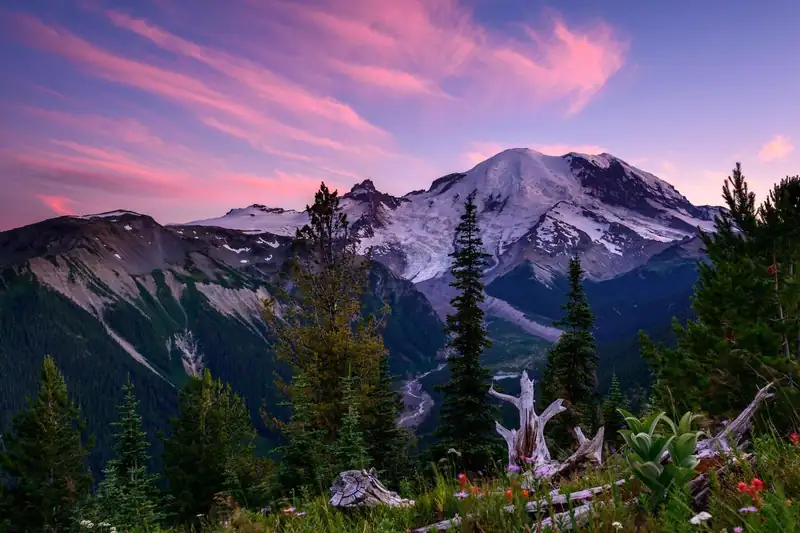
Mount Rainier National Park is a paradise for nature lovers, offering landscapes that range from lush meadows to rugged mountain peaks. With diverse hiking options and scenic drives, you’ll want to soak in every picturesque moment.
What to Do in Mount Rainier National Park
Top Experiences
- Hiking: Explore Mount Rainier’s diverse trails. Don’t miss these must-hikes:
- Skyline Trail: Circle around Paradise Valley on this loop trail for jaw-dropping views of Mount Rainier.
- Nisqually Vista Trail: Take this short, easy hike for prime views of the Nisqually Glacier and Mount Rainier.
- Comet Falls: Conquer this moderately difficult trail to witness a stunning 320-foot waterfall.
- Sunrise Area Trails: Choose from trails like Fremont Lookout and Naches Loop, especially gorgeous in summer when wildflowers are blooming.
- Scenic Drives: Drive to the Sunrise area for higher elevation views of Mount Rainier and visit the Paradise area famous for its vibrant wildflower meadows during peak season.
Where to Stay in Mount Rainier National Park
When visiting Mount Rainier, you’ve got a range of accommodation options, from rustic lodges to convenient campgrounds. Here’s a comparison to help you decide:
| Accommodation | Type | Price Range | Amenities |
|---|---|---|---|
| Paradise Inn | Lodge | $$$ | Historic charm, guided tours |
| National Park Inn | Lodge | $$ | Cozy rooms, dining options |
| Cougar Rock Campground | Campground | $ | RV sites, campfire rings |
| Ohanapecosh Campground | Campground | $ | Forest setting, ranger programs |
Choosing the right stay can enhance your park experience. Lodges provide comfort and amenities, while campgrounds offer a closer connection to nature.
Dining Highlights
Sampling local cuisine in and around the park lets you savor the Pacific Northwest flavors. Here are some dining options:
- Paradise Inn Dining Room: Enjoy classic American fare with stunning views.
- Copper Creek Inn: Just outside the park, this spot is known for its hearty meals and delicious blackberry pie.
- Wildberry Restaurant: Located nearby, it offers a unique blend of American and Nepalese dishes.
Transportation & Practical Tips
Getting around and making the most of your visit involves practical planning:
- Transportation: A reliable rental car is essential. The park has many scenic, but remote areas.
- Seasonal Variations: Summer (June to September) is ideal for hiking and wildflower viewing. Check road conditions before winter visits.
- Sustainability Tips: Practice Leave No Trace principles. Pack out all waste and respect wildlife.
- Budget Considerations: Entry fees are $30 per vehicle, valid for seven days. To save on costs, bring picnic supplies and opt for campgrounds if you’re budget-conscious.
Days 8-9: Mount Baker and Leavenworth
What to Do in Mount Baker
Mount Baker is not a national park, but its enchanting landscapes and diverse activities make it a must-visit. Here’s what you can’t miss:
- Skiing and Snowboarding: Mount Baker enjoys some of the heaviest snowfall in the country, perfect for skiing and snowboarding enthusiasts. With powder-packed slopes, it offers exhilarating runs for all skill levels.
- Hiking: Jump into the verdant trails of the Mount Baker-Snoqualmie National Forest. Popular routes like the Chain Lakes Trail and the Heliotrope Ridge Trail offer stunning vistas, from shimmering lakes to striking glacier views.
- Scenic Drives: The Mount Baker Highway (SR 542) is a visual symphony, showcasing panoramic views of the mountain and surrounding terrain. Snap photos and take in the awe-inspiring beauty.
- Wildlife and Nature: Encounter diverse wildlife, including black bears, mountain goats, and vibrant bird species. Engage all your senses with the pristine beauty of the forest, lakes, and rivers.
Where to Stay in Leavenworth
Leavenworth, a Bavarian-styled village known for its charming architecture and vibrant festivals, offers cozy and delightful accommodation options.
| Accommodation | Type | Price Range | Amenities |
|---|---|---|---|
| Bavarian Lodge | Hotel | $$-$$$ | Free breakfast, outdoor pool, walking distance to shops |
| Icicle Village Resort | Resort | $$-$$$ | Spa, hot tub, dog-friendly, multiple dining options |
| Pine River Ranch | B&B | $$-$$$ | Rustic cabins, breakfast delivery, private hot tubs |
| KOA Leavenworth | Campground | $ | RV/tent sites, pool, convenience store |
Dining Highlights in Leavenworth
Savor delicious German-inspired cuisine and local fares:
- Munchen Haus: Enjoy hearty bratwursts, pretzels, and house-made mustard in a festive beer garden.
- Andreas Keller Restaurant: Indulge in authentic Bavarian dishes like schnitzel and sauerkraut, paired with traditional music.
- Blewett Brewing Company: Sample craft beers and wood-fired pizzas in a relaxed setting.
- Visconti’s Italian Restaurant: For a change of pace, relish Italian classics made from fresh, local ingredients.
- Getting Around: Renting a car is the most convenient way to explore Mount Baker and Leavenworth.
- Best Time to Visit: For outdoor activities, visit Mount Baker in winter (December to February) for snow sports and July to September for hiking. Leavenworth’s festivals peak in summer and during Christmas.
- Sustainability Tips: Minimize your impact by staying on designated trails, packing out all trash, and opting for eco-friendly accommodations.
- Budget Considerations: Plan for varied expenses with options from luxury lodges to budget-friendly campgrounds and dining.
Jump into the heart of natural beauty and cultural charm as you continue your journey from Mount Baker’s snowy peaks to the enchanting streets of Leavenworth.
Days 10-11: North Cascades National Park
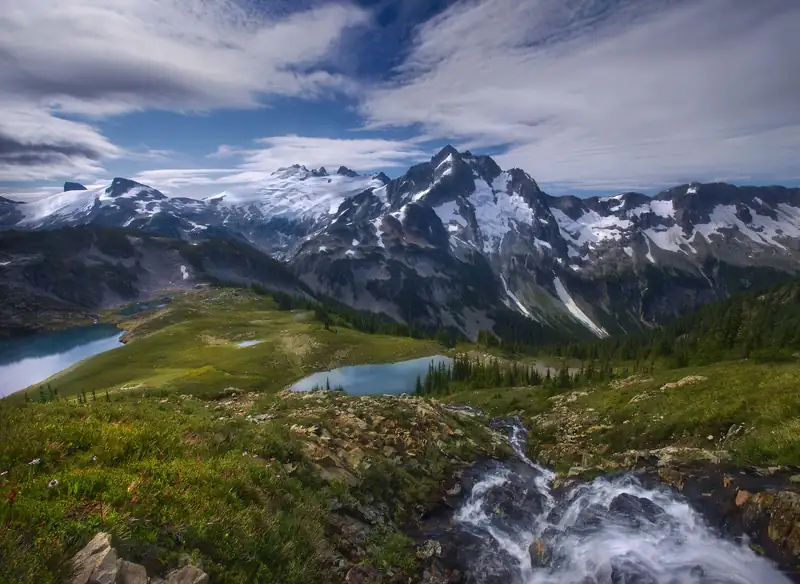
What to Do in North Cascades National Park
North Cascades National Park is a paradise for outdoor enthusiasts. It’s known for its rugged beauty and challenging trails, making it perfect for seasoned hikers. Here’s a glimpse of what you can look forward to:
- Chain Lakes Trail: A 6.5-mile loop offering breathtaking views. You’ll see pristine lakes and majestic mountains all along the trail.
- Heliotrope Ridge Trail: A 5.5-mile round-trip hike that takes you close to the stunning Coleman Glacier. Don’t forget your camera!
- Cascade Pass and Sahale Arm: This strenuous hike rewards you with spectacular views of the Cascade Range. Expect steep climbs but unparalleled scenery.
For those who prefer to enjoy the scenery from the comfort of their car, North Cascades has some of the most beautiful drives:
- Diablo Lake Vista Point: Offers a mesmerizing view of the turquoise-colored Diablo Lake. It’s a sight you won’t want to miss.
- Ross Lake National Recreation Area: Part of the North Cascades National Park Complex, this area is perfect for kayaking, fishing, and relaxing among nature.
Where to Stay in North Cascades National Park
Whether you’re looking for rustic camping or a cozy lodge, the North Cascades area has you covered. Here’s a comparison of some popular accommodations to help you decide:
| Accommodation Name | Type | Features | Price Range |
|---|---|---|---|
| Newhalem Campground | Campground | Scenic sites, ranger programs, close to trails | $15-25/night |
| North Cascades Lodge at Stehekin | Lodge | Waterfront views, access to trails and boating | $160-220/night |
| Ross Lake Resort | Cabin Rentals | Float cabins on the lake, fishing, hiking | $170-270/night |
| Colonial Creek Campground | Campground | Lakeside sites, fishing, kayaking | $20-35/night |
Dining Highlights
Dining options in North Cascades aren’t extensive, but they’re delightful. You can enjoy a mix of local flavors and classic park fare:
- Stehekin Pastry Company: Famous for mouthwatering baked goods. Don’t miss the cinnamon rolls.
- North Cascades National Park Service Complex: Grab-and-go snacks and simple meals near park entrances.
- Ross Lake Resort Store: Quick bites and supplies, perfect for refueling during your adventures.
Transportation & Practical Tips
Reaching and exploring the North Cascades requires some planning:
- Car Rental: Renting a car in Seattle or Vancouver is the best way to explore the park at your own pace.
- Public Transport: Limited options, so a car offers more flexibility.
- Seasonal Considerations: The best time to visit is June through October when the roads are open and the weather is mild. Snow can close some routes in winter.
- Sustainability Tips: Practice Leave No Trace principles, use refillable water bottles, and stick to marked trails to protect the park’s delicate ecosystems.
Budget Considerations: Camping is an economical option, while lodges and resorts provide more comfort at a higher cost. Pack your own snacks and meals to save on dining expenses.
Days 12-13: San Juan Islands

On Days 12-13, you’ll explore the enchanting San Juan Islands, located off the coast of Washington State. This cluster of islands offers diverse activities and breathtaking scenery, perfect for a relaxing and memorable conclusion to your road trip.
What to Do in San Juan Islands
- Whale Watching: Enjoy a guided tour to witness the renowned orca whale populations. Look for companies like San Juan Safaris or Western Prince, known for their knowledgeable guides.
- Kayaking and Paddleboarding: Traverse the serene waters around the islands. Local outfitters, such as San Juan Kayak Expeditions, provide excellent gear and tours. Expect to spot seals, sea lions, and a variety of bird species.
- Visit Local Islands: Don’t miss iconic destinations like San Juan Island, home to Friday Harbor, the historic Lime Kiln Point State Park, and the scenic trails of Orcas Island. Shaw Island offers a quieter experience with fewer crowds.
Where to Stay in San Juan Islands
For accommodations, you have various options catering to different tastes and budgets. Here’s a quick comparison:
| Accommodation | Location | Type | Price Range (per night) | Amenities |
|---|---|---|---|---|
| Earthbox Inn & Spa | Friday Harbor | Boutique Hotel | $100 – $250 | Spa, Indoor Pool, Free WiFi |
| Doe Bay Resort | Orcas Island | Cottages, Camping | $50 – $200 | Hot Tubs, Cafe, Ocean Views |
| Lakedale Resort | San Juan Island | Glamping, Lodge | $150 – $300 | Lake Activities, Free Breakfast |
- Transportation: Ferries from Anacortes are your main transport. Book in advance during peak seasons to secure your spot. Consider bringing your vehicle or rent bikes for easier island hopping.
- Seasonal Variations: Summer (July-August) is ideal for warm weather and whale watching. Fall provides fewer crowds and vivid foliage.
- Sustainability: Opt for eco-friendly tours and accommodations like LEED-certified lodges. Respect the delicate ecosystems—avoid single-use plastics and leave no trace.
- Local Cuisine: Sample fresh seafood at restaurants like Downriggers in Friday Harbor, or enjoy farm-to-table dining at Orcas Island’s The Mansion at Rosario Resort.
Indulge in a slice of Pacific Northwestern paradise in the San Juan Islands, where diverse landscapes and activities offer a perfect blend of adventure and tranquility.
Day 14: Return to Seattle
Final Day Activities
Start your final day early to make the most of your return to Seattle. Begin by visiting one of Seattle’s hidden gems, the Ballard Locks. Watch boats navigate the locks and explore the surrounding botanical gardens. Then, take a short drive to the Museum of Pop Culture (MoPOP), where interactive exhibits jump into music history, science fiction, and more.
After lunch, head to the Chihuly Garden and Glass Museum. Marvel at the incredible glass sculptures that blend art and nature seamlessly. If you’re up for more, walk over to the nearby Space Needle for unparalleled views of the city and beyond. End your day with a leisurely stroll through Pike Place Market. Shop for unique souvenirs, enjoy fresh seafood, and perhaps catch the famous fish throwers in action.
Where to Stay in Seattle
Your accommodation options in Seattle range from budget-friendly hostels to luxury hotels. For a unique stay, consider Hotel Max. Its artistic vibe and central location make it perfect for exploring downtown. If you prefer a more luxurious experience, the Fairmont Olympic Hotel offers elegant rooms with top-notch amenities.
For a more budget-friendly option, check out the Green Tortoise Hostel. Located near Pike Place Market, it provides both private and dormitory-style rooms and includes breakfast. Alternatively, the Ace Hotel in Belltown offers stylish accommodations at moderate prices, with a focus on sustainability practices.
| Hotel Name | Type | Price Range | Key Amenities |
|---|---|---|---|
| Hotel Max | Mid-range Boutique | $150 – $250 per night | Art-filled rooms, prime location, restaurant on-site |
| Fairmont Olympic Hotel | Luxury | $300 – $500 per night | Spa, fine dining, historic landmark |
| Green Tortoise Hostel | Budget | $30 – $100 per night | Free breakfast, communal kitchen, prime location |
| Ace Hotel | Moderate | $100 – $200 per night | Sustainable practices, free Wi-Fi, unique decor |
Each accommodation offers a different experience, but all will give you a comfortable base to explore Seattle on your last day.
Additional Destinations to Consider
Columbia River Gorge
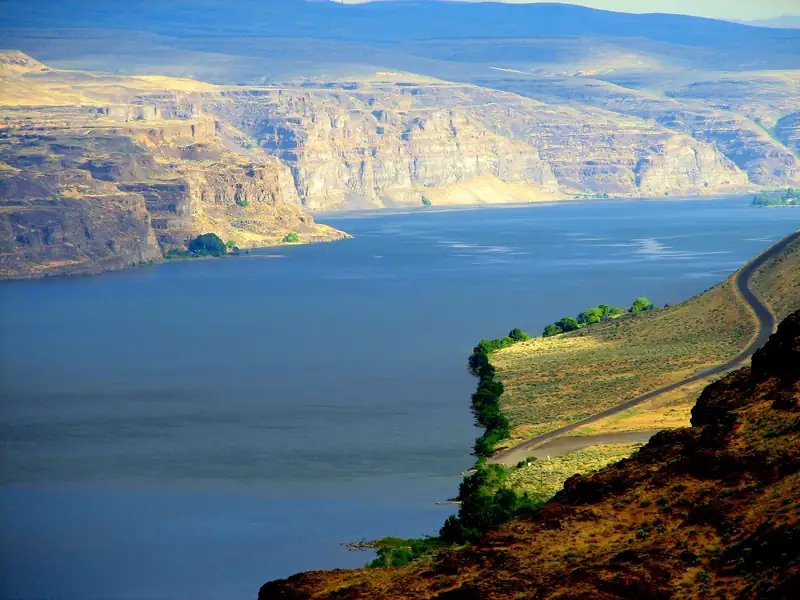
The Columbia River Gorge offers a breathtaking escape with its majestic waterfalls and scenic viewpoints. Straddling the border between Washington and Oregon, this region is perfect for outdoor enthusiasts and history buffs alike.
Top Attractions
- Multnomah Falls: Witness Oregon’s tallest waterfall, plunging 620 feet.
- Vista House: Enjoy panoramic views of the Gorge at this historic landmark.
- Hood River: Embrace a variety of water sports like windsurfing and kiteboarding.
- Columbia River Gorge National Scenic Area: Hike trails with stunning viewpoints and lush forests.
Hidden Gems
- Rowena Crest: Capture stellar photos of winding roads and vibrant wildflowers.
- Mosier Plateau Trail: Explore a tranquil hike with fewer crowds and expansive views.
- Cascade Locks: Discover this small town with its charming marina and historic locks.
Accommodations
| Accommodation | Type | Price Range | Highlights |
|---|---|---|---|
| Skamania Lodge | Resort | $$$ | Golf, spa, adventure park |
| Hood River Hotel | Historic Hotel | $$ | Centrally located, charming decor |
| Cascade Motel | Budget | $ | Cozy rooms, pet-friendly |
Dining Highlights
- Solstice Wood Fire Cafe: Relish farm-to-table pizzas and craft beers.
- Riverside Restaurant: Dine with a view, offering local cuisine and fresh ingredients.
- Dog River Coffee: Grab a specialty coffee in a cozy atmosphere.
Transportation & Practical Tips
- Driving: Easiest way to explore the Gorge; consider scenic routes like Historic Columbia River Highway.
- Seasonal Variations: Visit in spring for waterfalls and wildflowers, summer for outdoor activities, fall for foliage.
- Sustainability Tips: Stay on marked trails, use reusable water bottles, and support local businesses.
- Budget Considerations: Opt for picnicking and exploring free attractions to save money.
Oregon Coast
The Oregon Coast boasts dramatic landscapes with rugged cliffs, sandy beaches, and charming towns. Ideal for a relaxed getaway, it’s full of activities and scenic spots.
Top Attractions
- Cannon Beach: Admire the iconic Haystack Rock, perfect for photography.
- Oregon Dunes National Recreation Area: Ride ATVs or hike the dunes.
- Newport: Visit the Oregon Coast Aquarium and explore Yaquina Head Lighthouse.
Hidden Gems
- Ecola State Park: Wander through forested trails with stunning coastal vistas.
- Thor’s Well: Witness this natural wonder during high tide.
- Yachats: Discover quaint shops and local eateries in this quiet town.
Accommodations
| Accommodation | Type | Price Range | Highlights |
|---|---|---|---|
| Stephanie Inn | Luxury Hotel | $$$$ | Oceanfront view, fine dining |
| Adobe Resort | Mid-range Hotel | $$ | Seaside rooms, indoor pool |
| Driftwood Shores | Budget Hotel | $ | Direct beach access, family-friendly |
Dining Highlights
- Mo’s Seafood and Chowder: Famous for clam chowder by the beach.
- Local Ocean Seafoods: Enjoy fresh seafood with dishes straight from the docks.
- Pelican Brewing Company: Savor craft beers and pub food with ocean views.
- Driving: The Pacific Coast Highway offers the most scenic drive. Public transportation is limited.
- Seasonal Variations: Summer offers the best weather. Winter brings dramatic storms and quieter beaches.
- Sustainability Tips: Follow Leave No Trace principles and support eco-friendly tours.
- Budget Considerations: Save by staying in motels and enjoying free beach access.
Conclusion
Embarking on a 14-day road trip through Washington’s national parks promises an adventure filled with diverse landscapes and unforgettable experiences. From the lush Hoh Rainforest to the glacial peaks of Mount Rainier and the serene alpine lakes of North Cascades, you’ll encounter nature’s grandeur at every turn.
Careful planning and preparation will enhance your journey, allowing you to fully immerse yourself in each park’s unique offerings. Remember to pack essentials, embrace sustainable practices, and take time to savor local cuisine and hidden gems.
Whether you’re hiking, relaxing, or exploring charming towns, this itinerary ensures a seamless and enriching experience. Your journey through Washington’s natural beauty will leave you with cherished memories and a deeper appreciation for the Pacific Northwest’s stunning landscapes.
Frequently Asked Questions
What are the highlights of a 14-day road trip through Washington’s national parks?
The highlights include exploring Olympic National Park, Mount Rainier, and North Cascades. Activities involve hiking in the Hoh Rainforest, enjoying glacial peaks, and relaxing by alpine lakes.
How many days should I spend in each national park?
It’s recommended to spend 2-3 days in each park: Olympic National Park, Mount Rainier, and North Cascades for the best experience.
What are must-do activities in Olympic National Park?
Hike the Hall of Mosses trail, explore Rialto Beach, and enjoy views from Hurricane Ridge. The more adventurous can try the Mount Storm King hike.
Where should I stay during the trip?
Accommodation options include historic lodges, rustic lodges, campgrounds, and more. Specific lodges and campgrounds are highlighted for each park.
Are there dining options within the parks?
Yes, dining highlights include local seafood and American fare, with notable mentions like the Paradise Inn Dining Room.
What are the must-hike trails in Mount Rainier National Park?
Skyline Trail and Nisqually Vista Trail are must-hikes. Enjoy wildflower meadows and stunning vistas on these trails.
How can I travel sustainably during this trip?
Follow sustainability practices such as packing out all trash, staying on trails, and supporting local businesses. Tips are provided for each park.
Are there any hidden gems or additional destinations?
Yes, Shi Shi Beach is a hidden gem, and additional destinations like the Columbia River Gorge and the Oregon Coast are suggested.
Can I start my trip in Seattle? What are the attractions there?
Yes, starting in Seattle is ideal. Attractions include the Space Needle, Pike Place Market, and more.
Is whale watching available on this trip?
Yes, whale watching is available during the San Juan Islands portion of the trip, along with kayaking and other outdoor activities.
